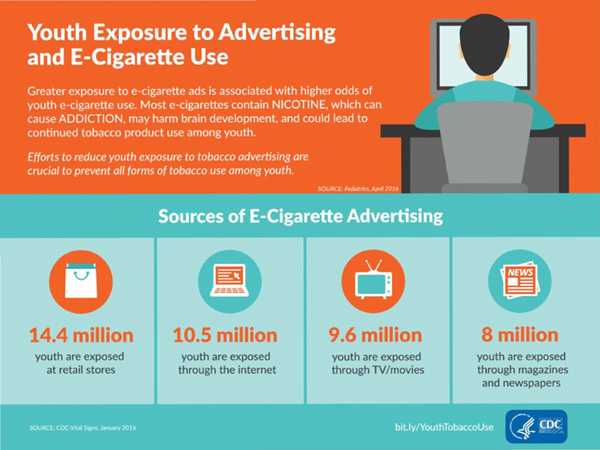A new study shows link between e-cigarette ads and use among youth
Reducing exposure to ads critical to prevent youth e-cigarette use
This website is archived for historical purposes and is no longer being maintained or updated.
Press Release
For Immediate Release: Monday, April 25, 2016
Contact: Media Relations
(404) 639-3286

Section 508-compliant PDF
There is a link between exposure to e-cigarette advertisements and the use of e-cigarettes by middle and high school students, according to a new study by the Centers for Disease Control and Prevention. This is the first study to assess the link between exposure to e-cigarette advertising and current e-cigarette use, and it concludes that efforts to reduce youth exposure to advertising are critical to prevent youth from using e-cigarettes as well as other tobacco products.
The study, published in the April 2016 edition of the journal Pediatrics, assessed current (past 30-day) use of e-cigarettes and exposure to e-cigarette advertising in four different types of media: retail stores, the internet, TV/movies, and magazines/newspapers. The National Youth Tobacco Survey (NYTS) is a school-based, self-administered questionnaire given to more than 22,000 middle and high school students in 2014.
Analyzing data from the 2014 NYTS, CDC researchers found that the greater the exposure to e-cigarette advertisements among middle and high school students, the greater the odds of their e-cigarette use. As noted in CDC’s Jan. 5, 2016, Vital Signs report on e-cigarette advertising exposure among youth, spending on e-cigarette advertising rose from $6.4 million in 2011 to an estimated $115 million in 2014.
During the same time, current e-cigarette use among youth soared; from 1.5 percent in 2011 to 13.4 in 2014 among high school students, and from 0.6 percent in 2011 to 3.9 percent in 2014 among middle school students. In 2014, e-cigarettes became the most commonly used tobacco product among youth, surpassing conventional cigarettes.
“Kids should not use any type of tobacco product, including e-cigarettes,” said CDC Director Tom Frieden, M.D., M.P.H. “Exposure to e-cigarette advertising is associated with youth e-cigarette use – and that is concerning to me as CDC Director, as a doctor, and as a parent.”
Protecting young people
States and localities can consider strategies to reduce youth exposure to e-cigarette advertising and marketing which include:
- Limiting tobacco product sales to facilities that never admit youth,
- Restricting the number of stores that sell tobacco products and how close they can be to schools,
- Limits on internet sales of e-cigarettes and other tobacco products
“Many of the ads we’re seeing for e-cigarettes today – that rely on sex, independence and rebellion – look eerily like the ads that were used to sell cigarettes and other conventional tobacco products for generations,” said Brian King, Ph.D., deputy director for research translation in the CDC’s Office on Smoking and Health. “Any tobacco use by youth is dangerous to their health. The unrestricted marketing of e-cigarettes and dramatic increases in their use by youth could reverse decades of progress in preventing tobacco use among youth.”
FDA has regulatory authority over cigarettes, cigarette tobacco, roll-your-own tobacco, and smokeless tobacco. The agency is finalizing a rule that, if finalized as proposed, will bring additional tobacco products such as e-cigarettes, hookahs, and some or all cigars under that same authority. Regulating the manufacturing, distribution, and marketing of tobacco products – coupled with proven population-based strategies – can reduce youth tobacco use and initiation. These strategies include funding tobacco control programs at CDC-recommended levels, increasing prices of tobacco products, implementing and enforcing comprehensive smoke-free laws, and sustaining hard-hitting tobacco cessation and prevention media campaigns.
- Page last reviewed: April 25, 2016 (archived document)
- Content source:



 ShareCompartir
ShareCompartir